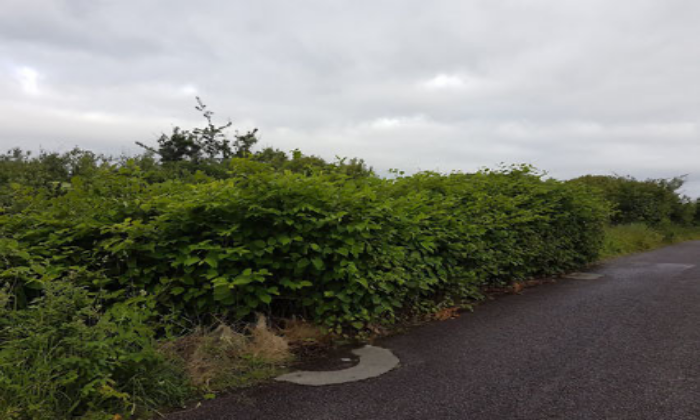Japanese Knotweed
Fallopia Japonica

If you find Japanese Knotweed, DO NOT CUT OR BREAK it!
Stem and root fragments can easily regrow as new plants.
– DO NOT TRANSPORT Japanese Knotweed anywhere. It is illegal to move Knotweed waste except to bring it to a licensed waste facility that has been given prior notification.
– Any eradication or control of Japanese Knotweed must be undertaken by a reputable invasive species control company. Poorly planned treatments will increase the plant’s resistance to future control methods!
If you encounter Japanese Knotweed please call us on Tel: 0876246355
or
email: paul@pswsvs.com
– Japanese Knotweed Fallopia Japonica is a rhizome based non-native invasive species that was introduced into the UK in the early nineteenth century by acclaimed botanist Philipp Franz Balthasar von Siebold.
– Due to the attractive nature of the plant and to stabilise banking it was then widely planted for several decades after which its invasive and destructive nature had gained notoriety. It is believed that the current infestation of Japanese Knotweed can be sourced back to a handful of plants imported by Von Siebold.
Every noted Japanese Knotweed plant in the Ireland is female.
Control systems and banning the sale of Japanese
– Knotweed was introduced & now it is controlled by a raft of government legislation, which to this day, is still being ignored in many cases.
Damage to property & Mortgage refusal
– Please note that Japanese Knotweed grows through gaps or imperfections in concrete and NOT through solid concrete as some less qualified or unscrupulous contractors and miss-informed articles have claimed it can.
– Some people are being refused a mortgage as a result of Japanese Knotweed growing on their property. If you’re experiencing these issues please call us for some free advice Japanese Knotweed can cause damage to property by finding gaps and expanding its growth. It can also out-compete native species and affect bio-diversity due to its lack of predators. It also undermines railway and river embankments by stripping it of nutrients.
– Japanese Knotweed is considered by the World Conservation union as one of the “Worlds Worst Species.”
Knotweed Legislation
Invasive Plant Species and the Law in Ireland
Irish law is very straightforward when it comes to the spread of Japanese Knotweed and other invasive plant species. The following is extracted from S.I. No. 477/2011 European Communities Regulations 2011, Part 6, Regulation 49 (see http://www.irishstatutebook.ie/eli/2011/si/477/made/en/print) which states that Prohibition on introduction and dispersal of certain species Regulation 49 (2) Save in accordance with a license granted under paragraph any person who plants, disperses, allows or causes to disperse, spreads or otherwise causes to grow in any place specified in relation to such plant in the third column of Part 1 of the Third Schedule, any plant which is included in Part 1 of the Third Schedule, shall be guilty of an offense.
The highlighted parts are particularly relevant which essentially states that anyone, who facilitates (by not doing anything to restrict the Japanese Knotweed or other invasive plant species spread) the growth of any plant species listed in the third column of Part 1 of the Third schedule (Japanese Knotweed is on this list amongst others) in any place (meaning the entirety of the state of Ireland – including private and public land) will have committed an offense and as such can be prosecuted.
In a nutshell, if you cause any of these listed invasive plant species to spread beyond your property and you fail to do anything about it whatsoever, the law as it is written, clearly states that the onus of responsibility falls on you and prosecution may follow.
Similarly, regulation concerning transport of invasive plant species are clear as specified in the following extract from S.I. No. 477/2011 European Communities Regulations 2011, Part 6, Regulation 50 (see http://www.irishstatutebook.ie/eli/2011/si/477/made/en/print) which states that: Prohibition on dealing in and keeping certain species Regulation 50 (1) Save in accordance with a licence granted under paragraph (7), and subject to Regulation 74, a person shall be guilty of an offence if he or she has in his or her possession for sale, or for the purposes of breeding, reproduction or propagation, or offers or exposes for sale, transportation, distribution, introduction or release—
(a) an animal or plant listed in Part 1 or Part 2 of the Third Schedule,
(b) anything from which an animal or plant referred to in subparagraph (a) can be reproduced or propagated, or
(c) a vector material listed in Part 3 of the Third Schedule, in any place in the State specified in the third column of the Third Schedule in relation to such an animal, plant or vector material.
Again, the highlighted parts are most significant as it clearly states that anyone who transports or distributes, introduces or releases any plant listed under Part 1 or Part 2 of the Third Schedule or any part of that plant that can reproduce (e.g. seeds, roots or stem material if applicable) or in the case of Japanese Knotweed, soils contaminated with rhizome (roots) in any place in Ireland (meaning the entirety of the state of Ireland – including private and public land) will have committed an offense and as such can be prosecuted.
To summarise this point, if you transport Japanese Knotweed from one location to another, to an altogether different location such as from one property boundary to another without the appropriate license to do so (along with any other of the listed plants) you are breaking the law and can be prosecuted.


